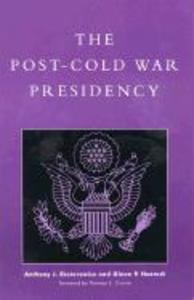
Zustellung: Fr, 01.08. - Do, 07.08.
Versand in 3-4 Wochen
VersandkostenfreiThis accessibly-written volume discusses socio-cultural, political, and economic changes during and after the Cold War period and how these have affected modern presidential leadership. Prominent contributors cover key issues-image and character, domestic and foreign policy, distraction theory, domestic and international economics, executive/legislative relations, security/intelligence, executive dominance, and activist government-and suggest strategies for helping to ensure a strong presidency in the future.
Inhaltsverzeichnis
Chapter 1 Foreword Chapter 2 Introduction Part 3 From Cold War to Global Presidency Chapter 4 Strategies for Presidential Leadership in the Post-Cold War Era Chapter 5 The Foreign Policy Presidency after the Cold War: New Uncertainty and Old Problems Chapter 6 Distracting Public Attention: Foreign Policy and the UN Chapter 7 The Incredible Shrinking Image: From Cold War to Globalist Presidency Part 8 The Post-Cold War Economic Presidency Chapter 9 The New Economy, the End of the Cold War, and Presidential Evaluations Chapter 10 Economic Intelligence and the CIA Part 11 The Post-Cold War Institutional Presidency Chapter 12 Formal Executive Power: The Contemporary Presidency Chapter 13 The White House Legislative Liaison Office: An Opportunity for Foreign Policy Inter-Branch Collaboration in the Post-Cold War Era Part 14 The Presidency and the Person Chapter 15 From Character to Convenience: What Really Matters in Presidential Politics Chapter 16 Bill Clinton as Warren Harding: The Post-War President as a Problem in American Political Development
Produktdetails
Erscheinungsdatum
08. Juli 1999
Sprache
englisch
Seitenanzahl
208
Herausgegeben von
Anthony J Eksterowicz, Glenn P Hastedt
Verlag/Hersteller
Produktart
kartoniert
Gewicht
272 g
Größe (L/B/H)
229/149/14 mm
ISBN
9780847691593
Pressestimmen
A diverse, edifying, and timely collection of essays which provide scholarly insight on the American presidency since the end of the Cold War. The editors have done an admirable job in taking such seemingly disparate essay topics and organizing them in a coherent manner. These essays provide excellent analysis of the topic, and through their eclectic nature, reflect the diversity of approaches taken towards understanding this institution that has been influenced by the end of the Cold War. Millennium The American presidency is a unique, necessary, and always potentially dangerous institution. In addition, it is an especially fragile institution and it is, as we are reminded again in these essays, a constantly changing institution... Anthony Eksterowicz and Glenn Hastedt have gathered a series of informative and in some cases provocative articles that help us to appreciate some of the changes that are taking place in this post-Cold War era. -- Thomas E. Cronin, from the foreword
Bewertungen
0 Bewertungen
Es wurden noch keine Bewertungen abgegeben. Schreiben Sie die erste Bewertung zu "The Post-Cold War Presidency" und helfen Sie damit anderen bei der Kaufentscheidung.







